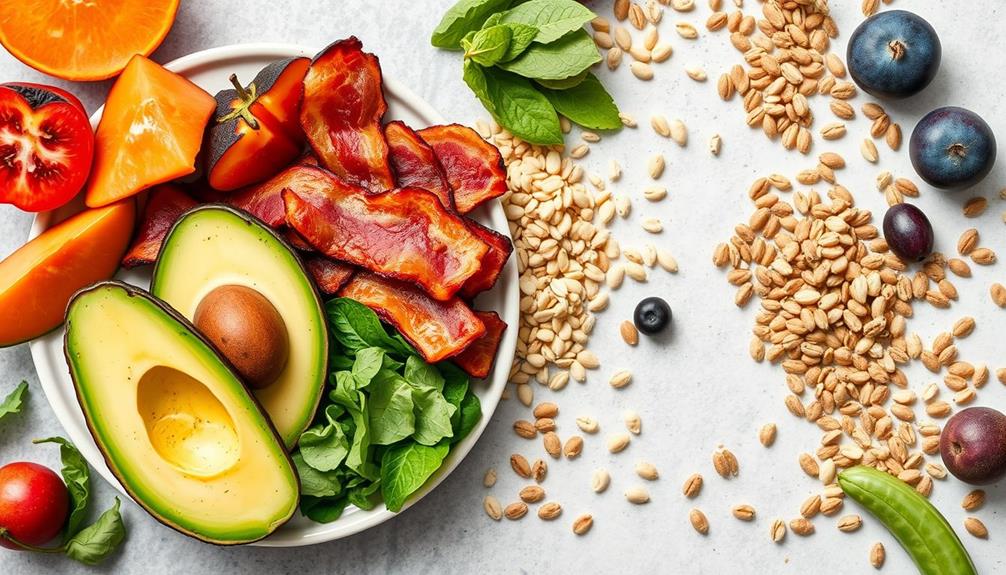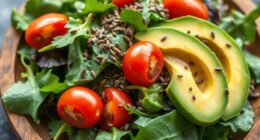The keto diet can be safe for many if you follow it properly, but it does have potential risks. While it may help with weight loss and energy levels, be aware of side effects like "keto flu," nutrient deficiencies, and digestive issues. Monitoring your health markers, like cholesterol and kidney function, is essential. Consulting a healthcare professional is recommended, especially if you have pre-existing conditions. By ensuring you're meeting your nutritional needs and staying hydrated, you can enjoy the benefits while minimizing risks. Discover more about potential alternatives and additional safety tips that might suit your lifestyle better. If you’re unsure about whether the keto diet is right for you, you may want to consider consulting with a registered dietitian who can provide personalized guidance. Additionally, educating yourself on the keto diet explained in detail can help you make an informed decision about whether it aligns with your health goals and lifestyle. Remember, there is no one-size-fits-all approach to nutrition, so it’s important to find a sustainable way of eating that works for you.
Key Takeaways
- The keto diet can lead to "keto flu," causing symptoms like headaches and fatigue during the initial transition phase.
- Long-term adherence may result in nutrient deficiencies due to restricted food groups, requiring careful planning.
- Increased LDL cholesterol levels from high saturated fat intake may pose cardiovascular health risks.
- Individuals with pre-existing health conditions should consult healthcare professionals before starting the keto diet.
- Regular monitoring of metabolic health markers is essential to ensure safety and address any potential risks.
Overview of the Keto Diet

The ketogenic (keto) diet is a high-fat, low-carbohydrate eating plan designed to shift your body into a state called ketosis. By restricting your carbohydrate intake to less than 50 grams per day, you force your body to rely on fat as its primary energy source instead of glucose.
This high-fat diet typically consists of 70-80% fat, 15-25% protein, and only 5-10% carbohydrates, creating a unique metabolic state that produces ketone bodies from stored fat for energy.
In addition to weight management, the keto diet may have potential benefits for certain health conditions, including benefits similar to those of natural remedies alongside conventional medications. Originally developed in 1921 by Dr. Russell Wilder at the Mayo Clinic for treating drug-resistant epilepsy, particularly in children, the keto diet focuses on health benefits beyond weight loss.
You'll commonly consume foods like fatty fish, meats, eggs, dairy, avocados, nuts, and low-carb vegetables while avoiding most fruits, grains, and sugars.
As your body evolves into ketosis, which usually takes about 2-4 days, you'll notice changes in your energy levels and overall health.
How the Keto Diet Works

Keto works by drastically reducing your carbohydrate intake to around 20-50 grams per day, pushing your body into a state called ketosis. In this metabolic state, your liver converts stored fat into ketone bodies, which become your primary energy source instead of glucose. This shift typically takes 2-4 days of strict adherence to the keto diet.
To maintain ketosis, your diet should consist of a high-fat intake, while greatly limiting carbs. Here's a breakdown of the macronutrient composition:
| Macronutrient | Percentage Range | Food Examples |
|---|---|---|
| Fat | 70-80% | Avocados, nuts, fatty fish |
| Protein | 15-25% | Poultry, eggs, cheese |
| Carbohydrates | 5-10% | Leafy greens, berries |
As you shift into ketosis, you might experience the "keto flu," with symptoms like headaches and fatigue. However, once your body adapts, many people report successful weight loss and increased energy levels. Embracing high-fat foods and a low-carb diet can transform your energy metabolism, making fat the star of your dietary show.
Dietary Composition and Guidelines

When you start the keto diet, understanding the macronutrient ratios is essential.
You'll want to focus on getting about 70-80% of your calories from fats, while keeping carbs to a minimum.
Incorporating foods rich in antioxidants, such as avocados, can enhance overall health, similar to the benefits noted with Cranberry Juice Consumption.
Choosing the right foods, like avocados and leafy greens, will help you stay on track and reach ketosis effectively.
Macronutrient Ratios Explained
Understanding macronutrient ratios is vital for successfully following a ketogenic diet. The typical macronutrient ratio for keto is around 70-80% fat, 15-25% protein, and 5-10% carbohydrates. This composition helps induce ketosis, where fat becomes your primary energy source.
Here's a quick overview:
| Macronutrient | Percentage | Example (2,000 calories) |
|---|---|---|
| Fat | 70-80% | 165g |
| Protein | 15-25% | 75g |
| Carbohydrates | 5-10% | 40g |
Incorporating healthy fats, such as nuts, seeds, avocados, and olive oil, is essential. While saturated fats from palm oil, lard, and butter are encouraged, be cautious of excess protein, which can hinder your shift into ketosis. Remember, the strict carbohydrate limit of 20-50 grams per day means you'll focus on low-carb vegetables and limited fruits like berries.
Maintaining this balanced macronutrient ratio is key to achieving the intended effects of the keto diet. With careful planning, you'll enjoy the benefits of this low-carb lifestyle while fueling your body effectively.
Food Choices Allowed
A well-planned ketogenic diet allows you to enjoy a variety of delicious and satisfying foods while keeping your carb intake low. Your food choices on this diet should focus on healthy fats, moderate proteins, and very limited carbohydrates to maintain ketosis. Incorporating essential oils like eucalyptus oil can enhance your overall well-being during this dietary change.
Here's a quick look at what you can include:
- Healthy fats: Nuts, seeds, avocados, olive oil, and fatty fish.
- Protein sources: Meats, eggs, and dairy products.
- Low-carb vegetables: Leafy greens and cruciferous options.
- Fruits: Berries in moderation due to their lower carbohydrate content.
You'll want to avoid high-carb foods like grains, sugars, starchy vegetables, and most fruits, which can hinder your progress.
By keeping your daily carb intake between 20-50 grams, you'll find it easier to achieve and maintain ketosis. The macronutrient distribution typically consists of about 70-80% fat, 15-25% protein, and only 5-10% carbohydrates.
With these allowed foods, you can create satisfying meals that not only support your diet but also keep you feeling full and energized. Enjoy the diversity of flavors while sticking to your ketogenic goals!
Potential Risks and Side Effects

What should you know about the potential risks and side effects of the ketogenic diet? One immediate concern is the "keto flu," which can hit you with symptoms like nausea, headache, fatigue, and dizziness. These symptoms typically resolve within a few days to weeks, but they can be uncomfortable.
Long-term adherence to this restrictive diet may lead to nutrient deficiencies, as it limits essential vitamins and minerals found in higher-carb foods. It's important to have a well-planned approach to your diet, similar to how you'd create a budget for managing finances, to guarantee you're meeting your nutritional needs.
You should also be aware that some people experience increased LDL cholesterol levels while on the keto diet, raising the risk of cardiovascular issues over time. Gastrointestinal distress is another common complaint, often due to the high-fat, low-fiber nature of the diet, leading to constipation or diarrhea.
Additionally, the combination of high protein intake and low carbohydrates can increase uric acid levels, putting you at risk for kidney stones. While the keto diet may offer benefits for some, it's vital to weigh these potential risks carefully and consider consulting a healthcare provider before making significant dietary changes.
Comparison With Other Diets

The ketogenic diet's strict carbohydrate limits set it apart from other popular diets like Atkins and Paleo. While both the keto and Atkins diets fall under low-carb diets, the keto diet restricts carbs to just 20-50 grams per day, whereas Atkins allows for a gradual reintroduction of carbs. This difference can influence your experience and outcomes markedly.
Additionally, the importance of meal planning to maintain ketosis can be vital for success on the keto diet, as it helps to avoid unintended carb consumption.
Here's how the keto diet compares:
- Short-term weight loss: You might see quicker results on the keto diet due to its high-fat approach, which often leads to rapid initial weight loss.
- High saturated fat: The keto diet emphasizes high saturated fat intake, similar to Atkins, raising concerns about LDL cholesterol levels and potential heart disease.
- Nutrient deficiencies: The restrictive nature of the keto diet can lead to nutrient deficiencies, a common concern also shared with other low-carb diets.
- Long-term sustainability: Both the keto and Atkins diets face challenges in maintaining weight loss over time, with many experiencing weight regain upon reintroducing carbohydrates.
Understanding these comparisons can help you make an informed decision about your dietary choices.
Long-Term Health Implications

Long-term adherence to the ketogenic diet can raise several health concerns that you should consider. One major issue is nutrient deficiencies, as the restrictive nature of the diet may lead to inadequate intake of crucial vitamins and minerals. This could affect your overall long-term health.
Additionally, the high saturated fat intake associated with the diet can increase LDL cholesterol levels, raising red flags about your cardiovascular health. Moreover, it's important to discuss personal risk factors with healthcare providers, much like how mammography guidelines recommend individualized strategies for early detection of health issues, including breast cancer.
In addition, research indicates potential risks like hepatic steatosis and a higher likelihood of developing kidney stones due to altered metabolic processes from high fat consumption. The diet's low fiber content can also contribute to digestive issues, such as constipation, which can impact your gastrointestinal health over time.
While the ketogenic diet may offer short-term weight loss benefits, the long-term health implications remain less understood, requiring additional studies. Consequently, it's crucial to weigh these risks before committing to this diet.
Being aware of these potential issues can help you make informed decisions about your health and wellness in the long run.
Recommendations for Safety

Starting the ketogenic diet can feel overwhelming, but taking safety precautions can help you navigate it more effectively. Before diving in, it's essential to consult with a healthcare professional, especially if you have pre-existing conditions like liver, pancreas, or kidney issues. This guarantees you're making a safe choice tailored to your health needs.
Additionally, understanding how dietary changes can affect your overall development and health—similar to how key domains of development in psychology impact growth—can provide valuable insight as you commence this new dietary path.
To maintain safe adherence to the keto diet, consider the following recommendations:
- Monitor your nutrient intake closely to prevent deficiencies in essential vitamins and minerals.
- Stay hydrated and consider electrolyte supplementation to help combat the "keto flu," which can cause headaches and fatigue in the initial phases.
- Regularly assess your metabolic health markers, including cholesterol levels and kidney function, to verify the diet is beneficial for your body.
- Gradually shift back to a balanced diet after completing keto to avoid weight regain and adverse health effects.
Alternative Approaches to Keto

If you're looking for alternatives to the keto diet, consider balanced low-carb diets that prioritize whole foods.
These approaches let you enjoy a variety of fruits, vegetables, and healthy fats while still keeping your carb intake moderate.
Additionally, understanding the impact of different brewing methods on caffeine content can help you make informed choices about your coffee consumption while on a low-carb diet, as various brewing methods can greatly affect your daily intake.
This balance not only supports your health but can also make your meal plan more sustainable in the long run.
Balanced Low-Carb Diets
When exploring alternatives to the ketogenic diet, balanced low-carb diets offer a more moderate approach that many find easier to maintain. These diets typically recommend a carbohydrate intake of about 100-150 grams per day, allowing for a variety of foods.
This flexibility helps you avoid the strict limits of the keto diet, making it less likely you'll experience issues like keto flu or digestive problems. Additionally, embracing a nurturing imaginative mindset can foster creativity in your meal planning and preparation, making the process more enjoyable and sustainable.
Here are some key benefits of balanced low-carb diets:
- Nutrient-dense foods: They emphasize vegetables, lean proteins, and healthy fats to prevent nutrient deficiencies.
- Sustainable lifestyle changes: You can incorporate a wider range of foods, promoting long-term adherence.
- Weight loss: Studies suggest they can lead to similar weight loss and metabolic benefits as the keto diet.
- Balanced macronutrient distribution: Typically consisting of 40-50% carbohydrates, 30-40% fats, and 20-30% proteins, they support a healthier dietary balance.
Focus on Whole Foods
Many people find that focusing on whole foods can transform their approach to the ketogenic diet. By emphasizing nutrient-dense options like avocados, nuts, seeds, fatty fish, and non-starchy vegetables, you can maintain low carbohydrate intake while ensuring your body gets essential vitamins and minerals.
This approach helps mitigate the risk of nutrient deficiencies often seen with more restrictive diets that rely heavily on processed high-fat foods. Additionally, individuals with emotional dysregulation, such as those with Borderline Personality Disorder, may benefit from a balanced diet that supports overall mental health.
Whole foods generally boast higher fiber content, which aids digestion and can alleviate constipation—a common issue with traditional keto diets. By prioritizing whole foods, you promote satiety and support metabolic health through the consumption of healthy fats, high-quality proteins, and low-glycemic carbohydrates.
Adopting a whole-foods approach encourages sustainable eating habits that can help you avoid rebound weight gain often associated with short-term restrictive diets. Instead of feeling deprived, you'll nourish your body with diverse, satisfying foods that support your health goals.
Ultimately, this balanced strategy can make your ketogenic journey more enjoyable and effective in the long run.
Frequently Asked Questions
What Are the Risks of the Keto Diet?
The keto diet carries risks like increased LDL cholesterol, "keto flu" symptoms, nutrient deficiencies, and potential kidney stones. You might also face constipation due to low fiber intake from limited fruit and vegetable options.
How Long Is It Safe to Be in Ketosis?
You can safely maintain ketosis for about 3 to 6 months, but individual responses vary. After that, you should monitor your health closely, as extended periods might lead to nutrient deficiencies and other complications.
Is There a Healthy Version of Keto?
Yes, there's a healthier version of keto! You can focus on nutrient-rich foods like avocados, nuts, and vegetables. This balanced approach helps you maintain essential nutrients while enjoying weight loss and metabolic health benefits.
What Are the Pros and Cons of a Keto Diet?
You might experience rapid weight loss and increased energy on the keto diet, but beware of potential pitfalls like nutrient deficiencies and the dreaded "keto flu." It's a balancing act between benefits and risks.
Conclusion
In summary, while the keto diet can offer impressive benefits, it's essential to approach it with caution. You don't want to end up feeling like a science experiment gone wrong! Make sure you're aware of the potential risks and listen to your body's needs. If you're considering the keto lifestyle, consult a healthcare professional and explore safer alternatives that might suit you better. Your health is your greatest treasure, so protect it wisely!









